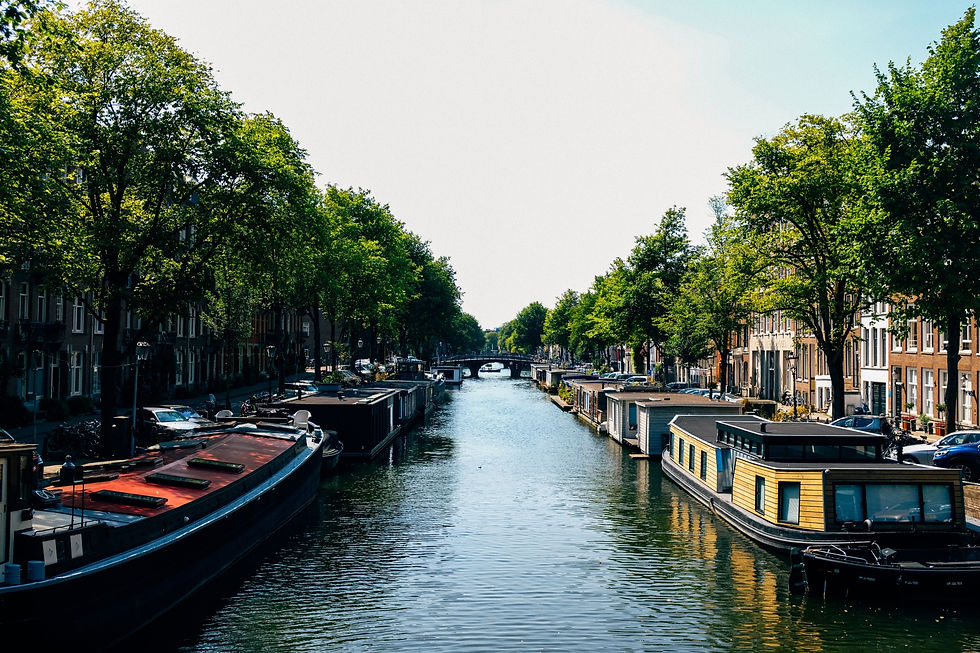Fun Facts About Clogs, Canals, and Cheese in Amsterdam
- Rosie Dietrich

- Feb 8, 2021
- 2 min read
Updated: Jun 18, 2021
Amsterdam is typically known for these 3 signature items. Let's learn some fun facts about these and see how well you know them. Make sure you scroll to the end and learn how Gouda is made at a 100-year old farm.
ABOUT CLOGS

The oldest pair of wooden shoes, dating back to 1230 to 1280, was discovered in Amsterdam. They were designed to protect the feet of factory workers, artisans, farmers, fishermen, and other trade jobs.
Clogs (Klompen) were a popular choice of footwear during the 1970s up to the early 1980s for both men and women.
In different styles of dance, clogs are the most common footwear of choice. The traditional clog dancing in the Netherlands is called Klompendansen.
Machine-made footwear was introduced in the early 20th century. Prior to that, all wooden clogs were handmade by skilled craftsmen.
Clogs or wooden shoes come in three different styles:
Wooden upper
Wooden overshoes
Wooden soled
ABOUT CANALS

If you were to combine all the Amsterdam canals, they would stretch over 100 kilometers long (60 miles)
There are over 160 Canals in Amsterdam
There are a whole lot of bridges in Amsterdam - 1700 in total. That's 1,300 more bridges than there are in Venice. A lot of these bridges can open up for the taller ships to come through. Roughly, 80 of these bridges are situated in the historic canal ring.
The historic canal ring is one of UNESCO's World Heritage Sites.
The canals of Amsterdam divide the city of Amsterdam into 90 different islands.
Most of the canals in Amsterdam were built during the Dutch Golden Age in the 17th century.
There are around 800,000 bicycles in Amsterdam because the Dutch love cycling. But some can be considered a bit reckless with the bikes because every year more than 10,000 bikes are fished out from different canals.
Some of the locals inhabit the canals of Amsterdam on a houseboat! There are roughly 3,000 houseboats in Amsterdam.
People sometimes swim in the murky Amsterdam canals, but it's not recommended because of the unknown hazards below the surface of the water.
Princess Maxima joined the Amsterdam City Swim back in 2012, a year before becoming Queen Maxima in 2013.

ABOUT CHEESE

Gouda is one of the oldest recorded cheeses in the world. Historians date the cheese back to the 12th century.
The cheese is named after the Dutch city of Gouda, not because it is produced in this region, but historically, farmers from the surrounding area would bring their cheese to sell in Gouda on market days.
It is traditionally made from cow's milk, although some artisan varieties use sheep's or goat's milk.
A few Dutch farmers still traditionally make the cheese, using unpasteurized milk. This cheese is called boerenkaas (farmers cheese). Most Dutch Gouda today is industrially produced.
Most North Americans wrongly pronounce Gouda as ‘GOO-duh.' The correct pronunciation is "GAOW duh" or "HOW-duh."
Check below how Dutch Gouda is Made
I don't know about you, but I'm seriously craving some gouda now. Did you learn something new? What were you most surprised by.
Leave a comment.




Comments